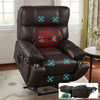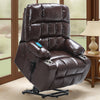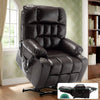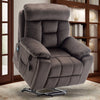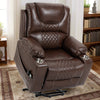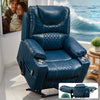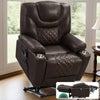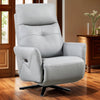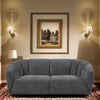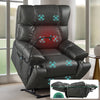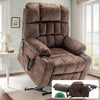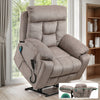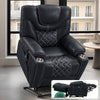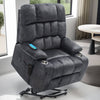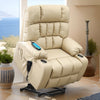The Advantages of Manual Recliners in Home and Office Spaces
Understanding the Mechanism of Manual Recliners
Manual recliners are a popular choice for many homeowners and office workers. These chairs use a simple lever or handle to adjust the position. When you pull the lever, it releases the backrest, allowing you to lean back. The footrest also extends, giving you a comfy spot to rest your feet.

One of the main benefits of manual recliners is their reliability. With fewer moving parts, they're less likely to break down. This makes them a great long-term investment. They're also often lighter than power recliners, making them easier to move around.
Manual recliners come in various styles. Some have a push-back design, where you use your body weight to recline. Others have a side lever for easy adjustment. No matter the style, manual recliners offer a simple, effective way to relax.
Ergonomic Benefits and Comfort Features
Manual recliners are designed with your comfort in mind. Many models offer lumbar support, which helps maintain proper spine alignment. This can reduce back pain and improve posture over time. The adjustable positions also allow you to find the perfect angle for your body.
Some manual recliners come with added comfort features. These may include:
- Padded headrests for neck support
- Wide armrests for added comfort
- Swivel bases for easy movement
- Rocking features for a soothing motion
These features can greatly enhance your relaxation experience. They also make manual recliners suitable for a wide range of activities. Whether you're reading, watching TV, or taking a nap, a manual recliner can provide the comfort you need.
Space-Saving and Versatility in Small Apartments
Manual recliners are an excellent choice for small living spaces. Many models are designed to be compact, taking up less floor space than traditional sofas. Some even come with wall-hugging features. This means they can be placed close to walls without hitting them when reclined.
The versatility of manual recliners makes them perfect for apartments. They can serve multiple purposes:
- A comfortable seat for relaxing
- An extra bed for guests
- A cozy spot for reading or working
Some manual recliners also come with built-in storage. This can be a great way to save space in small rooms. You can store blankets, books, or remote controls in the armrests or under the seat.
Power Recliners: Combining Convenience with Style
The Ease of Use: Why Power Recliners Are a Hit
Power recliners have gained popularity due to their ease of use. With just the push of a button, you can adjust your position. This makes them ideal for people with mobility issues or those who want effortless comfort. The smooth, quiet motors ensure a seamless transition between positions.

Many power recliners offer multiple preset positions. These can include:
- TV watching
- Reading
- Zero gravity
- Sleeping
Some advanced models even have memory functions. This allows you to save your favorite positions for quick access. The precise control offered by power recliners means you can find the exact angle that suits you best.
Power recliners are also great for those with limited hand strength. The electronic controls are much easier to operate than manual levers. This makes them a popular choice among seniors and people with arthritis.
Design and Aesthetic Appeal
Gone are the days when recliners were bulky eyesores. Modern power recliners come in sleek, stylish designs that can enhance any room decor. Many manufacturers offer a wide range of upholstery options. These include leather, microfiber, and high-quality fabrics in various colors and patterns.
Some popular design features of power recliners include:
- Slim profiles that blend with modern furniture
- Hidden footrests for a cleaner look
- Customizable options like contrast stitching or nailhead trim
Power recliners are available in various styles. From contemporary to traditional, there's a design to match every taste. Some even come as part of sectional sofas, allowing you to create a cohesive look in your living room.
Advanced Features and Enhanced Comfort
Power recliners often come with a host of advanced features for enhanced comfort. Many models include built-in massage functions. These can help relieve muscle tension and promote relaxation. Some even offer heat therapy for additional pain relief.
Other advanced features you might find in power recliners include:
- USB charging ports for your devices
- LED lighting for better visibility
- Cup holders and storage compartments
- Adjustable headrests and lumbar support
Some high-end models offer app connectivity. This allows you to control your recliner with your smartphone. You can adjust settings, set timers, and even track your relaxation habits.
Evaluating the Top Recliner Chairs in the Market
Key Considerations for Selecting Recliner Chairs
When choosing a recliner chair, there are several factors to consider. First, think about the size of your space. Measure the area where you plan to place the recliner. Remember to account for the fully reclined position. Also, consider the height of the user. Some recliners are better suited for taller or shorter individuals.

Comfort is crucial. Look for features like:
- Adequate padding
- Supportive backrest
- Adjustable headrest
- Smooth reclining mechanism
Durability is another important factor. Check the frame material and construction quality. Hardwood frames tend to be more durable than particle board. Also, look at the upholstery material. Leather and high-grade fabrics often last longer than cheaper materials.
Consumer Trends and Market Leaders in Recliner Chairs
The recliner market has seen some interesting trends in recent years. There's a growing demand for multi-functional recliners. These chairs often include features like:
- Built-in massage functions
- Heating elements
- USB charging ports
- Storage compartments
Smart recliners are also gaining popularity. These chairs can connect to your home's Wi-Fi network. They offer features like voice control and smartphone app integration. Some can even track your sitting habits and suggest healthier routines.
Several brands have emerged as market leaders in the recliner industry. La-Z-Boy remains a popular choice, known for their comfort and durability. Ashley Furniture offers a wide range of styles at competitive prices. For luxury options, brands like Stressless by Ekornes are highly regarded.
Long-term Quality and Warranty Options
When investing in a recliner, it's important to consider long-term quality. Look for chairs with sturdy construction and high-quality materials. Metal mechanisms often last longer than plastic ones. Check customer reviews to see how well the chair holds up over time.
Warranty options can give you peace of mind with your purchase. Most reputable brands offer warranties on their recliners. These typically cover:
- Frame defects
- Mechanism failures
- Upholstery issues
Some brands offer extended warranties for an additional cost. These can be worth considering for high-end recliners. Be sure to read the warranty terms carefully. Understand what's covered and for how long.
Regular maintenance can help extend the life of your recliner. This includes:
- Cleaning the upholstery regularly
- Lubricating moving parts
- Tightening loose screws or bolts
By choosing a high-quality recliner and maintaining it well, you can enjoy comfort for many years to come.








